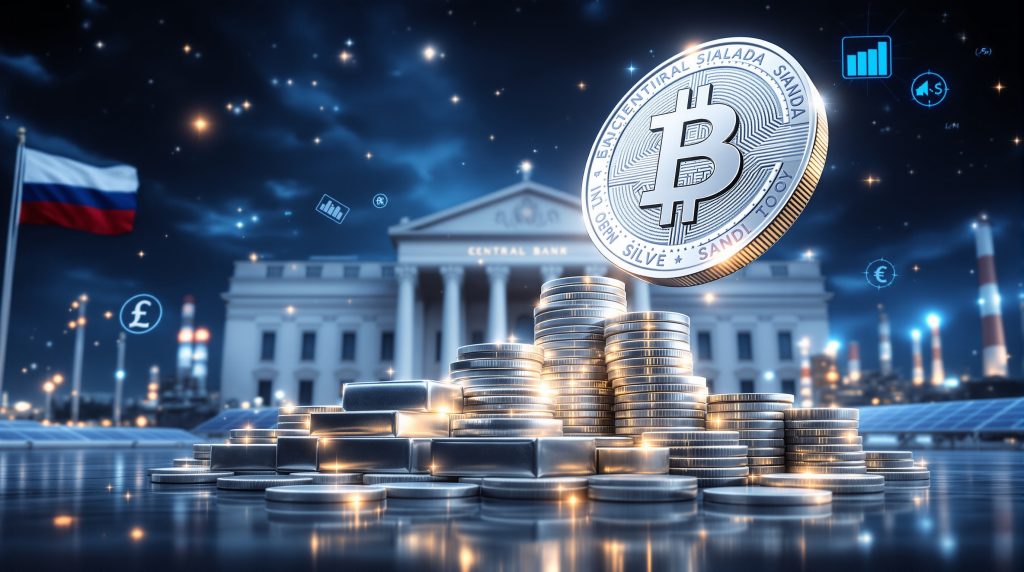How Are Central Banks Changing Their Approach to Silver? The Historical Context of Central Bank Silver Holdings For nearly 150 years, central banks worldwide have largely ignored silver as a reserve asset, focusing almost exclusively on gold. This long-standing tradition created a clear division in how monetary authorities viewed these two precious metals. While gold maintained its status as the premier reserve asset, silver was relegated to industrial and investment markets outside central banking systems. According to the World Gold Council's data, central banks collectively hold approximately 36,000 tonnes of gold globally, yet their silver holdings have remained negligible for decades. This stark contrast underscores the historical preference for the yellow metal in official reserves. The Paradigm Shift: Central Banks Enter the Silver Market A significant transformation began in 2023-2024 when several central banks started showing renewed interest in silver. This shift represents a fundamental change in monetary policy thinking, with implications for global market disruptions and investors alike. Central banks have begun diversifying their reserves beyond traditional assets, with silver emerging as a strategic addition to their portfolios. This development marks what industry analysts describe as a "watershed moment" in precious metals markets—the first time in generations that sovereign entities have actively considered silver as a component of their reserve strategies. The significance extends beyond the immediate market impact, potentially signaling a broader reassessment of silver's monetary role in the global financial system. Which Central Banks Are Leading the Silver Buying Trend? Russia's Strategic Silver Acquisition Program Russia has emerged as the pioneer in this new central bank approach to silver. The Russian central bank implemented a formal silver acquisition program, marking the first major sovereign commitment to silver in generations. This program includes substantial allocations specifically earmarked for building silver reserves, demonstrating a deliberate strategy rather than opportunistic purchasing. The Russian approach represents a calculated diversification away from dollar-denominated assets while strengthening domestic monetary reserves with tangible, inflation-resistant assets. Saudi Arabia's Entry into the Silver Market Following Russia's lead, Saudi Arabia became the second major central bank to make significant moves into the silver market. While their approach differed slightly—initially focusing on silver-backed exchange-traded products rather than exclusively physical holdings—the intent signals a similar strategic shift. Saudi Arabia's investment choices reflect a broader reassessment of reserve assets among oil-producing nations, who are increasingly looking beyond traditional financial instruments to preserve wealth. Other Nations Showing Interest Several other central banks have begun exploring silver acquisition programs, though with less publicity than Russia and Saudi Arabia. This growing interest suggests the beginning of a potential trend rather than isolated decisions by a few countries. India has also demonstrated increasing interest in silver, though its approach has traditionally focused more on citizen purchasing patterns than official reserves. Historically, Indian silver demand has been driven by cultural factors, with rural communities particularly active in acquiring silver jewelry and ornaments as a store of value. However, recent indications suggest potential shifts toward more formal reserve considerations. What's Driving Central Bank Interest in Silver? Economic Diversification and De-dollarization Efforts Central banks are increasingly seeking to reduce dependency on any single currency or asset class. Silver offers an alternative store of value that operates outside traditional banking systems, providing: Independence from the dollar-dominated financial system Protection against potential sanctions or financial restrictions Diversification of national wealth into tangible assets This trend aligns with broader de-dollarization efforts observed among various emerging economies seeking greater monetary autonomy. The People's Bank of China, for instance, has increased gold reserves for 18 consecutive months through May 2024, demonstrating the growing appetite among central banks for precious metals analysis. Industrial Demand Creating Supply Constraints Unlike gold, silver faces substantial industrial demand pressures that affect its availability: Silver Demand Category Annual Volume (Million Oz) Percentage of Total Demand Industrial Applications 680.5 52% Investment 310.2 24% Jewelry & Silverware 235.8 18% Photography 33.5 3% Other 39.0 3% This dual nature as both a monetary and industrial metal creates unique supply dynamics that central banks are increasingly recognizing as strategically valuable. According to The Silver Institute's World Silver Survey 2024, global silver demand reached 1.242 billion ounces in 2023, with industrial applications accounting for 656.9 million ounces (52.9%). This industrial component includes critical sectors like electronics, solar energy, and medical applications—all expected to grow substantially in coming years. Structural Supply Deficits The silver market has entered a period of persistent supply deficits, with global mine production unable to meet combined industrial and investment demand. Key factors include: Declining ore grades at major silver mines Limited new silver project development Rising production costs affecting mining economics Growing industrial applications, particularly in green technology The Silver Institute reports that global silver mining production reached 822.2 million ounces in 2023, falling significantly short of total demand. This structural deficit creates an attractive fundamental backdrop for central banks looking to acquire assets with favorable supply-demand dynamics. How Does Silver Compare to Gold for Central Banks? Market Size and Liquidity Differences The silver market presents different characteristics than gold for central bank operations: Characteristic Silver Market Gold Market Annual Production (2024) 830 million oz 120 million oz Market Capitalization ~$40 billion ~$13 trillion Price Volatility Higher Lower Storage Requirements 80× more space per dollar More efficient storage These differences create both challenges and opportunities for central banks considering silver allocations. The gold market's significantly larger capitalization—approximately $15 trillion compared to silver's $1.4 trillion—provides greater liquidity and stability for large-scale central bank operations. However, this size differential also means that even modest central bank silver purchases could have proportionally larger impacts on the silver market. Price Performance and Volatility Considerations Silver has historically demonstrated greater price volatility than gold, which presents both risks and potential rewards for central bank reserves: Higher potential appreciation during precious metals bull markets Greater downside risk during market corrections More sensitivity to industrial economic cycles Based on CBOE Volatility Index calculations for 2024, gold's 30-day price volatility typically ranges between 15-25% annualized, while silver often exceeds 30-40%. This higher volatility profile requires central banks to develop more sophisticated risk management strategies when incorporating silver into their reserves. Complementary Rather Than Replacement Strategy Central banks appear to be adopting silver as a complement to gold holdings rather than a replacement. This approach allows them to: Maintain the stability of traditional gold reserves Add the growth potential of silver Diversify across the precious metals spectrum Hedge against different economic scenarios This complementary approach recognizes the distinct qualities each metal brings to a comprehensive reserve strategy. Gold provides stability, global acceptance, and efficient value storage, while silver offers industrial utility, potential for greater percentage gains, and deeper connections to technological advancement. What Impact Could Central Bank Buying Have on Silver Markets? Potential Price Implications Central bank participation could fundamentally alter silver market dynamics. Even modest allocations from multiple central banks would represent significant demand in a relatively small market: If central banks allocated just 1% of their reserves to silver, it would require approximately 170 million ounces This represents over 20% of annual global silver production Such demand would likely exceed available supply at current production levels The International Monetary Fund reports that total central bank reserves globally exceed $12 trillion, meaning a 1% allocation to silver would require approximately $120 billion in silver purchases. At current silver prices, this would represent approximately 3.8 billion ounces—nearly five years of global mine production. Effects on Market Structure and Liquidity Increased central bank participation could transform silver market structure in several ways: Reduced available inventory for industrial users Higher baseline demand supporting price floors Greater institutional interest following central bank leadership Potential for strategic rather than purely economic acquisition decisions A historical precedent exists in the Hunt Brothers' attempted silver market squeeze in 1979-1980, which accumulated approximately 100 million ounces and drove prices from $11 to $50 per ounce. Central bank buying could potentially exert similar influence but on a more sustainable, long-term basis. Long-Term Implications for Silver's Monetary Role The re-emergence of central banks as silver buyers could gradually restore silver's historical monetary role: Enhanced perception as a legitimate reserve asset Greater recognition of silver's dual monetary/industrial nature Potential for silver to regain some of its historical monetary status Creation of a two-tier precious metals reserve system (gold and silver) This shift would represent a return to historical norms rather than a revolutionary change. Throughout most of human history, silver served alongside gold as a monetary metal, with the gold-silver ratio analysis historically averaging closer to 15:1 rather than today's approximately 84:1. How Are Silver Inventories and Supply Responding? COMEX and Exchange Inventory Levels Silver inventories on major exchanges have reached critically low levels: COMEX registered silver inventories dropped to approximately 44.8 million ounces as of December 2024 This represents less than two weeks of global industrial demand The ratio of paper silver contracts to physical backing has increased substantially The London Bullion Market Association vaults held approximately 1.14 billion ounces of silver as of November 2024, representing a significant portion of above-ground investment-grade silver. However, this inventory serves multiple market functions beyond potential central bank demand. Mining Production Challenges The silver mining sector faces significant challenges in responding to increased demand: Most silver (approximately 70%) comes as a byproduct of other metal mining Primary silver mines represent only about 30% of global production Development timelines for new mines typically exceed 5-7 years Environmental permitting has become increasingly restrictive Hecla Mining Company, one of the largest primary silver producers, reported production costs averaging $15.50 per ounce in Q3 2024, highlighting the economic challenges facing dedicated silver miners. These production constraints limit the industry's ability to rapidly increase supply in response to new central bank demand. Recycling and Secondary Supply Sources Secondary supply sources provide limited relief to market tightness: Silver recycling has become more efficient but remains constrained Industrial applications often use minimal amounts that are uneconomical to recover Photographic recycling, once a major source, has diminished with digital technology The U.S. Geological Survey notes that silver is essential in photovoltaic cells, with solar panel installations requiring approximately 20 grams of silver per panel. As renewable energy adoption accelerates, this demand source continues to grow while recycling technologies struggle to keep pace. What Should Investors Understand About This Trend? Differentiating Between Central Bank and Retail Investment Central bank silver acquisition differs fundamentally from retail investment in several ways: Strategic rather than tactical timeframes Ability to hold regardless of short-term price movements Different storage and security capabilities Potential for coordinated action with other central banks Private investors should recognize that central banks operate with different objectives and constraints than individual market participants. While retail investors may be concerned with near-term price movements, central banks typically implement decade-long strategic asset allocation plans. Potential Investment Implications For private investors, central bank silver buying carries several implications: Validation of silver as a legitimate monetary asset Potential reduction in available supply for private investment Possible floor under prices during market corrections Long-term structural support for the silver thesis Physical silver ETFs like PSLV and SLV collectively hold approximately 350 million ounces, representing less than half of annual global production. Central bank participation could significantly impact this investment segment by altering available supply and market sentiment. Risk Factors and Considerations Despite the positive implications, several risk factors remain: Central bank buying could prove temporary rather than structural Industrial demand could decline during economic contractions Mining companies might accelerate production in response to higher prices Political considerations could influence central bank decisions beyond economics Investors should maintain perspective on the silver-to-gold price ratio, which currently stands at approximately 84:1, compared to the historical average of 60:1 over the past century. This relative valuation metric provides context for silver's potential adjustment path should central bank buying accelerate. How Might This Trend Evolve in the Coming Years? Potential Expansion to Other Central Banks The trend could expand beyond early adopters to include: Other BRICS nations seeking alternatives to dollar reserves Smaller nations with historical connections to silver currencies Resource-rich countries looking to diversify sovereign wealth The Bank for International Settlements reports that Central Bank Digital Currency (CBDC) pilots are being conducted by over 100 countries as of 2024, creating another potential intersection with precious metals policies as nations reconsider their monetary frameworks. Integration with Digital Currency Developments Central bank silver acquisition could intersect with the development of central bank digital currencies (CBDCs): Potential for silver-backed digital currencies Use of silver as partial backing for new monetary systems Integration of precious metals into next-generation payment systems This convergence of traditional tangible assets with emerging digital frameworks could create novel monetary structures that incorporate silver's physical properties with the efficiency of modern financial technology. Long-term Structural Changes in Silver's Role The re-emergence of central banks in the silver market could lead to lasting changes: Formal recognition of silver alongside gold in reserve asset classifications Development of new silver-based financial instruments for central bank use Potential for coordinated silver acquisition programs among allied nations Gradual restoration of silver's historical monetary function These changes would represent a return to silver's traditional role throughout most of monetary history, when it served as "the people's money" alongside gold's position as the premier reserve asset. What Are the Key Takeaways About Central Bank Silver Buying? Historical Significance of the Trend The return of central banks to the silver market represents a historically significant shift after generations of absence. This development signals a potential reassessment of silver's monetary role in the global financial system. The London Bullion Market Association reports that central bank gold purchases reached 1,037 tonnes in 2023, the second-highest annual total since 1967. A similar trend developing in silver would represent a fundamental change in the market's structure and functioning. Supply-Demand Implications Central bank buying adds a new demand component to an already tight silver market: Industrial demand continues to grow, particularly in green technology Investment demand has remained resilient Mining production faces structural constraints Central bank buying creates additional pressure on limited supplies The resulting supply-demand dynamics could create persistent upward pressure on silver prices, particularly if multiple central banks begin implementing acquisition programs simultaneously. Strategic Considerations for Market Participants All silver market participants should consider the strategic implications of this emerging trend: Industrial users may need to secure longer-term supply arrangements Investors might reconsider allocation sizes given potential supply constraints Mining companies could accelerate exploration and development Financial institutions may develop new silver-based products to meet central bank needs The potential for silver to regain aspects of its historical monetary role represents both a challenge and opportunity for market participants across the spectrum from industrial users to investors. FAQ: Central Banks and Silver Reserves Why have central banks historically preferred gold over silver? Central banks have traditionally favored gold due to its higher value density (requiring less storage space), greater price stability, and established role in the international monetary system. Silver's industrial usage and higher volatility made it less attractive for reserve purposes during the 20th century. Silver requires approximately 68 times more storage space than gold for equivalent dollar value at current price ratios, creating logistical challenges for large-scale reserve holdings. This practical consideration has influenced central bank preferences throughout the modern era. Could central bank silver buying significantly impact prices? Yes, central bank participation could substantially impact silver prices due to the relatively small size of the silver market. Even modest allocations from multiple central banks would represent significant demand relative to annual production and available inventory. The limited size of the silver market—with annual production of approximately 830 million ounces and a market capitalization around $40 billion—means that even small percentage allocations from central bank reserves could create substantial price effects. Are central banks buying physical silver or paper derivatives? The approach varies by country. Russia has focused primarily on physical silver acquisition, while Saudi Arabia initially utilized silver-backed exchange-traded products. The trend appears to favor physical holdings for long-term strategic reserves. SLV (iShares Silver Trust) requires minimum creation/redemption units of 50,000 shares, with each share representing approximately one ounce of silver. This structure provides central banks with potential pathways to physical metal through authorized participant status. How does silver compare to gold as a reserve asset? Silver offers different characteristics than gold as a reserve asset, including higher potential growth, greater industrial utility, more volatility, and different storage requirements. Most central banks appear to be adding silver as a complement to existing gold safe haven insights rather than as a replacement. The U.S. Geological Survey reports that gold's annual mine production is approximately 3,100 tonnes globally, while silver production is about 25,000 tonnes, creating different market dynamics and supply considerations for central banks evaluating these metals. What percentage of reserves are central banks allocating to silver? Current allocations remain relatively small, typically less than 1% of total reserves. However, even these modest percentages represent significant silver demand given the size of central bank balance sheets relative to the silver market. For context, the Bank of Russia's official reserve composition shows gold holdings of approximately 2,335 tonnes as of December 2024, representing about 20% of its total reserves. Silver allocations, while growing, remain a fraction of this gold position. How might this trend affect private silver investors? Private investors may benefit from increased institutional validation of silver, potential price appreciation due to supply constraints, and greater market attention to silver's monetary role. However, they may also face increased competition for available physical supply. The key for private investors is understanding the different time horizons at play—central banks typically implement multi-decade strategies, while retail investors often operate with shorter timeframes. This difference creates both complementary and competitive dynamics in the market. Further Exploration: Readers interested in learning more about central bank approaches to precious metals can also explore related educational content, including industry reports on changing reserve asset preferences and the historical relationship between silver and monetary systems. Want to Capitalise on the Next ASX Resource Discovery? Discover why major mineral discoveries can lead to exceptional returns by exploring Discovery Alert's dedicated discoveries page, where their proprietary Discovery IQ model has successfully identified significant ASX opportunities before the broader market. Begin your 30-day free trial today to receive real-time alerts on potentially transformative mineral discoveries.

Australia-Canada Critical Minerals Partnership: Strategic Alliance for Secure Supply Chains
Discover how Australia-Canada critical minerals partnership creates resilient supply chains,



